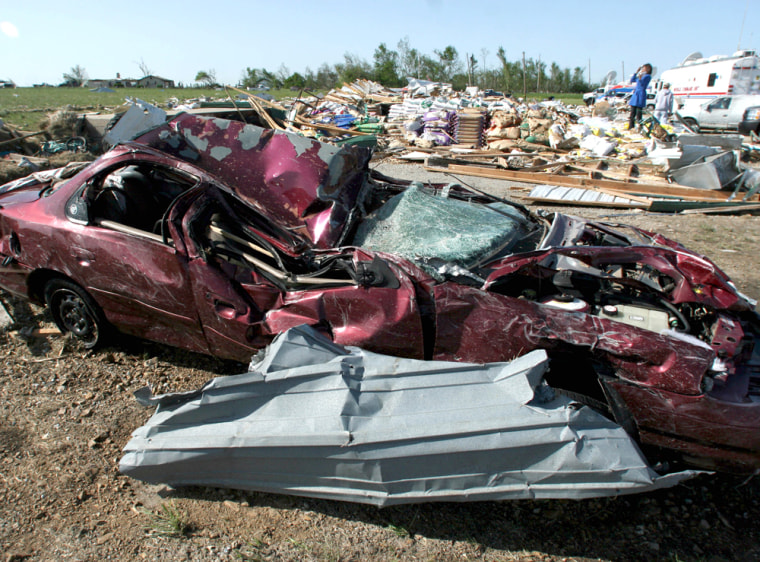Nearly half of the 21 people killed by a tornado that smashed parts of Oklahoma and Missouri over the weekend died in cars, troubling experts who say vehicles are among the worst places to be during a twister.
"It's like taking a handful of Matchbox cars and rolling them across the kitchen floor," said Sgt. Dan Bracker of the Missouri State Highway Patrol, surveying the damage in Newton County near the Oklahoma line, the hardest hit area. "This is devastating."
Among those killed were a woman who took shelter in a broken-down car outside someone's home; three people who were rushing to reach a relative's house in their car; and four family members — Rick Rountree, his wife, his 13-year-old son, and his mother-in-law — who were in a van on the way to a friend's wedding when the twister, packing winds of 170 mph, struck the Seneca area on Saturday night.
"They were on the road when the warnings came," said Rountree's brother-in-law, Larry Bilke.
Worst death toll in a decade
About 100 people have died in U.S. twisters so far this year, the worst toll in a decade, according to the National Weather Service, and the season isn't over yet. Tornado season typically peaks in the spring and early summer, then again in the late fall.
This could also prove to be the busiest tornado season on record in the United States, though the final figure on the number of twisters is not yet in.
All together, at least 24 people died in Missouri, Oklahoma, Georgia and Alabama after the severe storms erupted Saturday over the Southern Plains and swept east.
According to data from the National Weather Service's Storm Prediction Center, 49 of the 705 deaths — or about 7 percent — attributed to tornadoes from 1997 to 2007 were people who were in vehicles when the storm struck.
"They can cover more ground than you can in your car, so unless you know you are moving away from the tornado the best thing you can do is find a strong structure," said National Weather Service meteorologist Andy Foster.
The twister that struck Newton County was covering ground at 50 mph to 60 mph, Foster said. One car was found a half-mile from the tornado track.
Authorities were still piecing together how some of the other victims died over the weekend. But the Missouri Highway Patrol said at least two other car passengers were killed when their vehicle was thrown from the same road where the Rountree family was killed.
Another woman died in Missouri after she took shelter in a broken-down car outside Susan Roberts' home in Seneca. "That is what is tearing me up," Roberts said, adding she had warned the woman about the approaching tornado.
Car deaths in Oklahoma
In Picher, Okla., 32 miles away, a man and a woman died when their car was blown into a lagoon. The body of another man from the car wound up in a tree nearby. A 13-year-old girl who was riding in the car was injured.
Fire Chief Jeff Reeves said they were not trying to outrun the twister.
"I think they were actually trying to get to a family member's house on the south side of town to help them and they just didn't make it over," Reeves said.
Val Castor, one of the many spotters who bring dramatic video of tornadoes to local TV stations in Oklahoma, said the number of people on the road during tornadoes seems to have increased every year since 1996, when the movie "Twister," which depicts meteorologists chasing tornadoes, came out.
He said driving during severe weather is extremely dangerous for the inexperienced because they don't know where a tornado will form or what direction it will go. Heavy traffic or a broken-down vehicle can stop people from getting away from the funnel cloud.
"The best advice is to make sure the tornado is completely gone before you venture out," he said.
After the tragedy, Missouri Gov. Matt Blunt warned people to say out of vehicles when a tornado is nearby.
Lie flat in a ditch or low spot
Weather experts say motorists and their passengers should find a sturdy shelter or lie flat in a ditch or other low spot, covering their heads with arms, coats or blankets if the tornado is moving in their direction. Overpasses and bridges should also be avoided — the overpass can create a wind-tunnel effect, and bridges can collapse.
The death toll from tornadoes this year is the highest since 130 people were killed in 1998, according to the weather service. The highest number of tornado-related deaths came in 1953, when 519 people died.
To date this year, 858 tornadoes have been reported in the U.S., although that number probably includes numerous duplicate sightings of the same twister.
Harold Brooks of the National Severe Storms Laboratory said the highest number of tornadoes ever recorded through May 11 of any year was in 1999, when 676 tornadoes were counted. Brooks said he expects the number of confirmed tornadoes through mid-May of this year to end up in the 650-to-700 range.
Altogether, 15 people died in Missouri from the same storm that devastated Picher, where six were killed. Two more people were killed in Georgia, where forecasters said at least six tornadoes touched down. One of those twisters struck McIntosh County's emergency management center, destroying the fire trucks and ambulances inside. Another man was killed in Alabama when his truck was hit by a tree limb as he was surveying storm damage.
The Environmental Protection Agency said it would check for high lead levels in Picher after the tornado blew through the heavily polluted former mining town where lead-filled waste is piled into giant mounds.
Miles Tolbert, Oklahoma secretary of the environment, said he did not believe there was any immediate hazard to the 800 residents. But he said more testing was needed.
